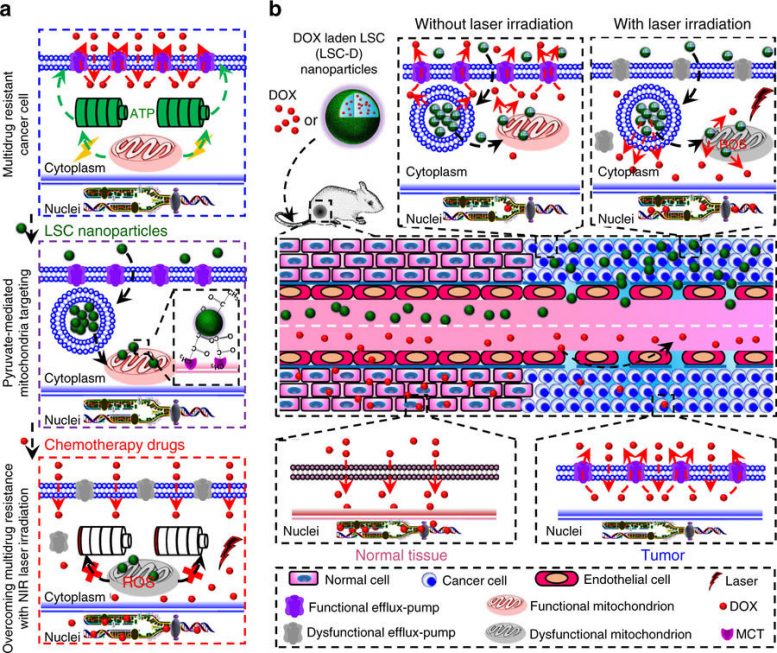
A schematic illustration of the strategy for overcoming cancer drug resistance. a The transmembrane P-glycoprotein (P-gp) efflux pump driven by adenosine triphosphate (ATP) is a major mechanism of cancer multidrug resistance. In this study, a novel lipid membrane-coated silica-carbon (LSC) nanoparticle is designed to target the monocarboxylate transporters (MCTs) on mitochondria through the pyruvate groups on the surface of the LSC nanoparticle. With near infrared (NIR, 800 nm) laser irradiation, the LSC nanoparticles produce reactive oxygen species (ROS) to oxidize NADH into NAD+ in mitochondria, which compromises ATP production. This results in dysfunction of the P-gp efflux pumps. In addition, the treatment of LSC nanoparticles with NIR laser irradiation (LSC + L) leads to not only transmembrane but also intracellular distribution of the P-gp efflux pumps, although the total amount of the efflux pumps is only slightly (albeit significantly) reduced. Collectively, the LSC + L treatment can be used to overcome the multidrug resistance of cancer cells, which is demonstrated using three different chemotherapy drugs in this study: doxorubicin hydrochloride (DOX), paclitaxel (PTX), and irinotecan (CPT-11). b Owing to their nanoscale size (~45 nm), the DOX-laden LSC (LSC-D) nanoparticles can preferentially accumulate in tumor as a result of the enhanced permeability and retention (EPR) effect of tumor but not normal vasculature to minimize systemic toxicity of the chemotherapy drug. After arriving in tumor, the LSC-D nanoparticles can be taken up by multidrug-resistant cancer cells, but the DOX released out of the nanoparticles can still be pumped out of the cells for the LSC-D treatment alone. Importantly, with NIR laser irradiation, the drug resistance of the multidrug-resistant cancer cells can be overcome and effective tumor destruction ensues. In contrast, free DOX can diffuse into both normal tissue (which causes systemic toxicity) and the multidrug-resistant tumor. Moreover, free DOX can be pumped out of the multidrug-resistant cancer cells and further diffuse back into blood perfusion, leading to ineffective cancer therapy. Hai Wang, et al.
The ability for cancer cells to develop resistance to chemotherapy drugs – known as multi-drug resistance – remains a leading cause for tumor recurrence and cancer metastasis, but recent findings offer hope that oncologists could one day direct cancer cells to “turn off” their resistance capabilities.
New findings put forth by University of Maryland Fischell Department of Bioengineering Professor Xiaoming “Shawn” He and researchers from five other academic institutions point to a technique that uses specially designed nanoparticles and near infrared laser treatment to cause cancer cells to lose their multidrug resistance capabilities for days at a time. This creates a therapeutic window for chemotherapy to combat even the most drug-resistant cells left behind after surgery or earlier treatment. The group’s findings were published today in Nature Communications.
“By administering chemotherapy within this ‘therapeutic window,’ oncologists could apply a lower dose of chemotherapy drugs to patients, with the potential for an improved treatment outcome – all while minimizing drug toxicity to healthy organs,” He said.
One of the primary reasons cancer cells develop resistance is the overexpression of what are known as efflux pumps – proteins that protect a cell by pumping out unwanted toxic substances before they can reach their intended target. In the same way that efflux pumps work hard to protect against toxins, they also expel virtually all clinically relevant chemotherapy drugs.
Fortunately, efflux pumps require a source of chemical energy to perform their function. As such, by cutting off the energy supply to the efflux pumps, oncologists could lower – or even eliminate – a cell’s resistance to drugs, such as those administered for chemotherapy. Recognizing this, He and his research team developed a way to reduce the amount of chemical energy – adenosine triphosphate (ATP) – available to the efflux pumps in cancer cells.
The team – which also included researchers from Ohio State University, University of Virginia, University of Missouri School of Medicine, Shanghai University of Traditional Chinese Medicine, and Indiana University School of Medicine – targeted a specially designed nanoparticle to the mitochondrion, the cell’s power generator wherein the cell converts oxygen and nutrients into ATP. Once the nanoparticles reach the cancer cells’ mitochondria, the researchers apply near infrared laser treatment to trigger a chemical reaction that reduces the amount of ATP available to the pumps and, thus, cuts off their power supply. Such treatment both reduces the expression of the efflux pumps and decreases their distribution on the cell plasma membrane.
The research team’s findings demonstrate that the drug-laden nanoparticles – in combination with near infrared laser treatment – can effectively inhibit the growth of multidrug-resistant tumors with no evident systemic toxicity.
While researchers have long worked with nanoparticles for drug delivery, the findings put forth by He and his team represent a crucial breakthrough in addressing multidrug resistance in cancer cells.
“For years, researchers have focused on delivering more chemotherapy drugs into cancer cells using nanoparticles, without targeting the root of drug resistance,” He said. “This meant that the cancer cells maintained their ability to expel the chemotherapy drugs, which limited any enhancement of the cancer therapy. To address this challenge, our research group is using nanoparticles not only to deliver more chemotherapy drugs to the target site within cancer cells, but also to compromise the function of the efflux pumps and thereby significantly improve safety and efficacy of cancer therapy.”
Publication: Hai Wang, et al., “Targeted production of reactive oxygen species in mitochondria to overcome cancer drug resistance,” Nature Communications, volume 9, Article number: 562 (2018) doi:10.1038/s41467-018-02915-8

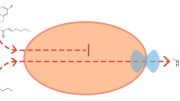
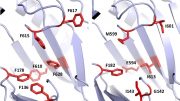
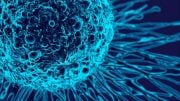
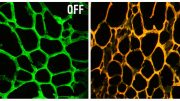
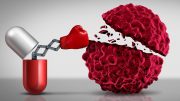
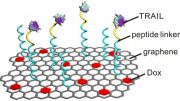
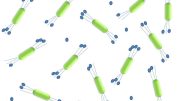
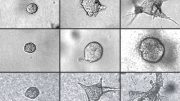
Be the first to comment on "Breakthrough Technique Uses Nanoparticles to Combat Cancer Drug Resistance"